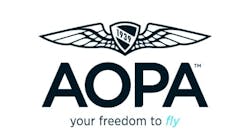Borescopes
Some tips on effective inspection techniques
By Joe Escobar
Photos Courtesy of Olympus Industrial, 2001
November 2001
Rigid scopes
Just as the name implies, rigid scopes are non-flexible inspection scopes. They allow access to remote areas that do not require the flexibility of fiber or video scopes. Their advantage is the clarity of the image. Rigid scopes use optics (mirrors and lenses) to project the image to the eyepiece, so the resolution is clearer than those produced with fiber optics. Their disadvantage is their rigidity that keeps them from maneuvering into some areas.
Fiberscopes
Another type of borescope is a fiberscope.
It uses fiber optic strands to project the image from the tip of the probe to the eyepiece. It’s advantage is it’s flexibility. It is able to bend into areas that may be impossible to get to with a rigid scope. The head of the probe is also able to be maneuvered once in place, say within a compressor turbine area, in order to get different fields of view.
Fiberscopes are also able to be manufactured in small diameters. Joel Young of Nanuet, New York-based Olympus Industrial America Inc. shares, "We have scopes that go down to 0.025-inch in diameter that will look inside the coolant holes of a turbine blade to see if there are any obstructions or possible FOD damage. You just can’t get down that small with a video scope at this time."
Videoscopes
The newest member of the borescope family is the videoscope. It is similar to the fiber scope in appearance and operation, but that is where the similarities end.
A videoscope uses a charged coupled device (CCD) to capture the image at the distal tip of the scope. It sends the image electronically through the flexible scope to the camera control unit (CCU).
Videoscopes have revolutionized borescope inspections. Since the images are digital files, they are able to be stored electronically for future reference. In addition, they can be e-mailed to get instantaneous input from someone at a remote location, such as the engine manufacturer’s technical help desk for example.
Know your equipment
The first thing that you need to do is to know how to operate your equipment. Read the user’s manual. The manufacturer intended it to be more than just ballast on your bookshelf. If you have a fiberscope, learn how to control the inspection head. Become comfortable maneuvering it and learn its limitations.
Videoscopes have more issues that you need to address such as taking images, storing them, and downloading them to a computer.
Take advantage of any training available from the manufacturer. The bottom line is get to know the equipment and how it operates so that you can make the most of your investment.
Know what you are viewing
An important thing to consider when doing a borescope inspection is that you must know what you are viewing. It takes more than being able to make your way to a power turbine and looking at it. You need to know what a good part looks like. How can you determine that the part you are inspecting is bad if you don’t know what a good one looks like? Also, you need to be aware of what defects you are looking for and the manufacturer’s serviceability limits. When you are first starting off, having a good supervisor or co-worker that can teach you these things is invaluable.
Watch the lighting
In many instances, you need to watch out
for bright lighting. If you are outside in the bright sun, you need to give your eyes time to adjust when you look into the scope. In addition, bright light can affect the ability to see images clearly on some display screens. Try to perform borescope inspections inside the hangar for optimum clarity.
In many instances, the engine manufacturer lists approved scopes in their maintenance manual. They may specify a particular size, type, or even manufacturer. Always follow their recommendations as applicable.
Probably nothing can be more frustrating than poor quality borescope equipment. If you are using a scope with poor optics and dim lighting, you are severely reducing the chances of detecting defects during the inspection. You need to make sure the equipment is
in good working condition.
New borescope tools
When I first started out in the industry, basically all that was available for borescope inspections were fiberscopes and rigid scopes. There were a limited amount of manufacturers and options available. But in recent years, the technology has advanced at a rapid pace. There are so many tools available today that can make our job easier. Let’s take a look at some of these tools.
Dye penetrant inspection
No, I didn’t get sidetracked — I am still talking about borescopes. What I didn’t know and found amazing is that dye penetrant inspection can now be done through the borescope itself! Olympus Industrial America manufactures videoscopes that have canisters attached to them. They allow cleaners and liquid penetrant to be applied to remote areas right through the fiberscope itself. The scope has a liquid light guide cable that allows for efficient transmission of UV light. The mechanic can view the image on an LCD screen and toggle between normal lighting for a visual inspection and black light for a dye penetrant inspection.
Working tools
In the old days, mechanics used chewed bubble
gum creatively attached to the end of a borescope to try to remove debris from otherwise inaccessible areas. There are now high-tech tools to do this job. Several manufacturers now offer working tools that can either ride along the scope or through an integrated working channel within the scope itself. Some of the tools available include loop snares, forceps grabbers, magnets, and measurement gauges. They offer the ability to remove foreign objects from within engines and other remote areas without disassembly.
A recent addition to the tools available for borescope inspection is 3-D stereo defect measurement. Instead of estimating defect size or using attached physical measuring gauges, the stereo measuring system allows for instantaneous and precise measurement. The system, which is available from Olympus, uses a special tip with two objective lenses in it. It then calculates the location of an object based on the differences in what each lens is seeing. The mechanic then uses the controls on the videoscope to point and click on areas he wants to measure.
But the neat thing about the system is that once the image is saved to a file, it can be re-measured at any time. The software allows for this re-measurement, even for dimensions that were not included in the first measurement. So if you measured a gouge on the leading edge, you could go back later and measure the distance from the blade root, or any other measurement you want to. You can even email the image — as long as the person that you are e-mailing it to has the software installed, he can also take any measurement he wants.
Match the scope to your needs
With so many options available today and so many different manufacturers, it is important to do some research and talk to the different manufacturers to determine what scope is best for you. Based on your needs and budget, they should be able to help you choose a scope that best fits your requirements, while giving you some room to grow.
Hopefully this article has helped a little by offering some insight and tips on how to make the most of your borescope inspections.








